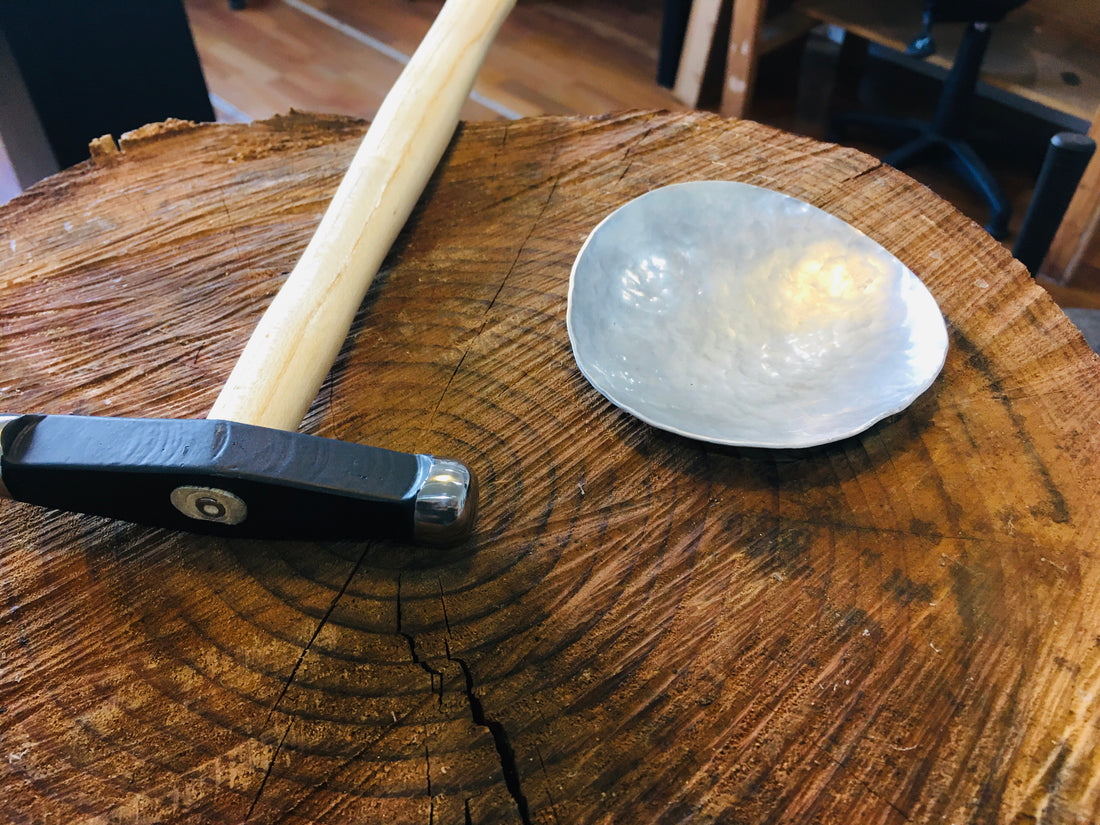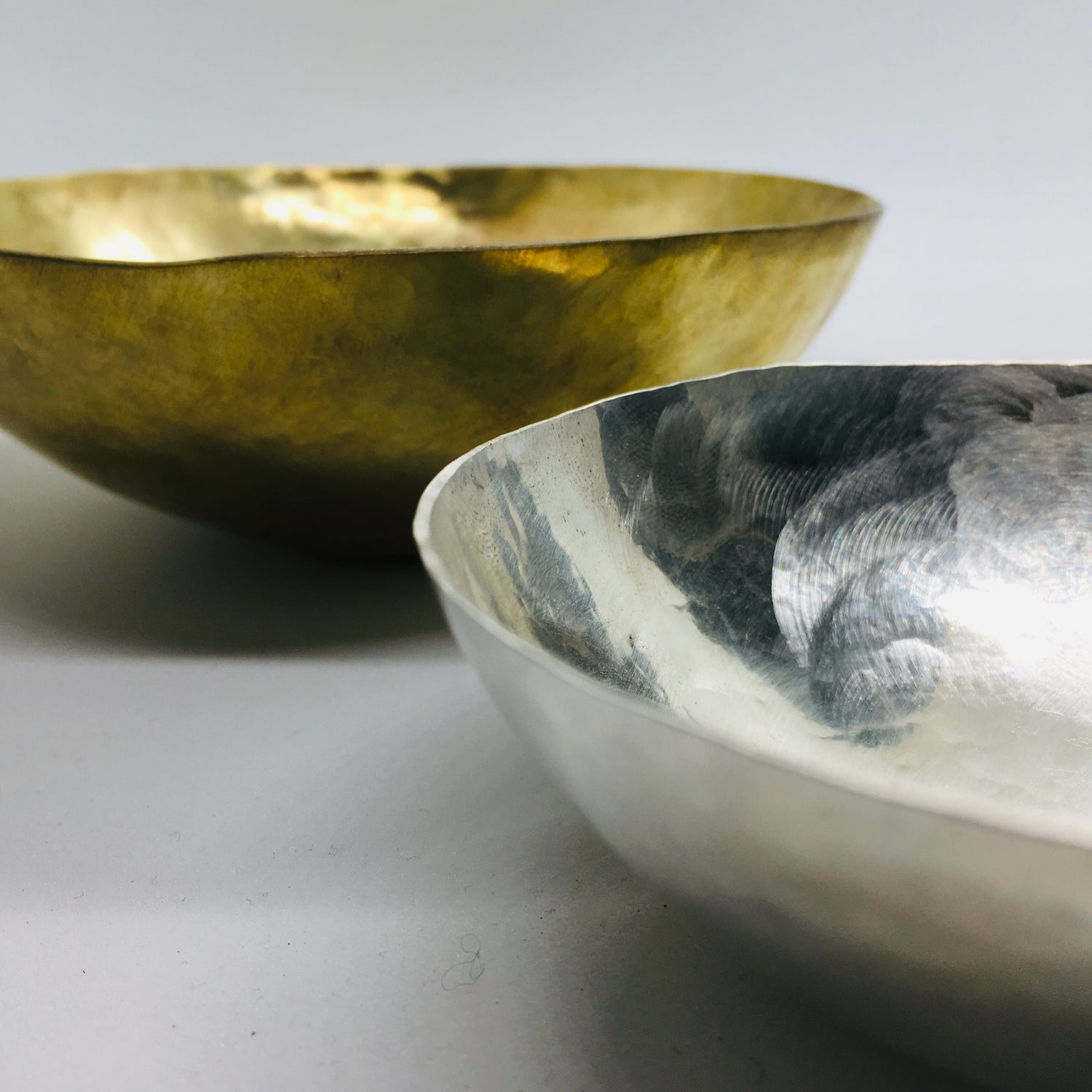In this blog we will look at the top 5 hammers for silversmiths and jewellers, to mold, shape, craft and manipulate the metal they are working with, into various shapes, sizes and forms for jewellery and objects.
Hammers are used for shaping and forge metals into desired forms. They come in various shapes and sizes for different purposes, such as planishing, raising and chasing hammers.
In this blog we will go through the top 5 hammer tools used by silversmiths and jewellers in forming metal - Bell Pein Hammers, Rawhide Mallet, Brass Hammers, Repousse Hammers, Planishing Hammers and Riveting Hammers.
Table of Content
1. Ball Pein Hammer
The Ball Pein Hammer is one of the top 5 most frequently used Hammer tools by Jewellery and Silversmiths alike
A ball-peen hammer, also spelled as ball-pein hammer, is a type of hammer characterised by a rounded, ball-shaped end opposite a flat or slightly rounded end. The term "peen" refers to the end opposite the striking face.

Ball Pein Hammers are commonly used in metalworking tasks such as shaping and forming metal. The rounded end, or peen, can be used for rounding off edges, shaping metal surfaces.
2. Rawhide Mallet
The Rawhide Mallet, is the second in the list of top 5 Hammer tools used by Jewellers and Silversmiths.
A rawhide mallet is another type of Hammer. The head composed of rawhide, which is the untreated hide of an animal, most often from cows or horses. The rawhide is typically shaped into a cylindrical or rounded form and securely attached to a handle, usually made of wood.
The rawhide material provides a degree of elasticity and resilience, allowing it to absorb some of the force of the blow while still delivering enough impact to perform the intended task. Rawhide doesn't leave marks or scratches on softer materials like silver or gold, making rawhide the ideal hammering tool to use on softer, precious metals and jewellery.
3. Brass Hammers
The Brass Hammer is the third on my list as the top 5 most used Hammer tools by Jewellers and Silversmiths.
A brass hammer is a type of hammer used in silversmithing. The head is made of brass which is a softer metal compared to steel Hammers. Brass hammers are used primarily for tasks where a softer impact is needed to avoid damaging delicate metalwork, such as forming, shaping, or texturing metal surfaces.
The softer nature of brass reduces the likelihood of leaving marks or dents on the metal. Additionally, brass hammers are often preferred for tasks involving non-ferrous metals, as they help to prevent cross-contamination and minimise the risk of sparking compared to steel hammers.
4. Repousse Hammers
The Repousse Hammer is number 4 in the top 5 most used Hammer Tools for Jewellers and Silversmiths alike.
A repoussé hammer is a specialised hammer used in the art of repoussé and chasing. Repoussé is a metalworking technique in which metal is shaped or ornamented by hammering from the reverse side to create a design in low relief. Chasing is the technique of refining and detailing the design from the front side using small punches and chisels.
The repoussé hammer typically has a rounded or ball-shaped end on one side and a flat or slightly convex end on the other. These different ends allow the silversmith to achieve different effects when working with metal. The rounded end is used for shaping and forming the metal from the reverse side, while the flat end is used for refining and detailing the design from the front.

5. Planishing Hammer
And finally but not lastly is the Planishing Hammer, which comes in at No 5 as the Top 5 Hammer tools used by Jewellers and Silversmiths.
A Planishing Hammer consists of a smooth, slightly convex hammer head mounted on a handle. The head of the hammer is often made from hardened steel or polished metal to prevent marring or damaging the surface of the metal being worked on. In silversmithing, a planishing hammer is primarily used for shaping and smoothing metal surfaces. It's commonly employed to refine the shape of a piece of silverware or jewellery, removing any imperfections or irregularities left by previous forming or shaping processes such as forging or raising.

The planishing process involves striking the metal surface with the smooth, rounded head of the hammer in a controlled manner. This action compresses and evens out the metal, creating a smooth, uniform surface texture. It can be used to flatten metal, remove dents, and refine shapes, resulting in a polished and professional finish.
Planishing hammers are often used in conjunction with other metalworking tools and techniques to achieve the desired shape and finish for the silver object. They are essential for achieving intricate designs and smooth, polished surfaces in silversmithing projects.
6. (Bonus!) Riveting Hammer
Bonus round..... the Riveting Hammer is another top Hammer used by Jewellers and Silversmiths.
A riveting hammers is a specialised tool used to drive in rivets. Rivets are small pieces of metal fasteners used to join two or more pieces of metal together permanently. The riveting hammer has two heads. One head is round, flat face, for striking the head of the rivet. The other end, is a chisel-shaped head, used for shaping the end of the rivet once it's been driven through the materials being joined.

Riveting Hammers come in various sizes, shapes and depths, depending on the application of metals being used. Jewellers tend to use small riveting hammers, while silversmith use larger and heavier hammers.
So as you can see, we have been through the top 5 Hammer tools used by silversmiths and jewellers alike to achieve different effects with metals.
More Blogs by Rahaima
- What is Silversmithing? by Rahaima
- Cubic Zirconia Vs Lab Grown Diamonds by Rahaima
- What is 925 Sterling Silver? By Rahaima
Reference Materials
- Corwin, Nancy Megan, "Chasing & Repoussé: Methods Ancient and Modern", Brynmorgen Press,





